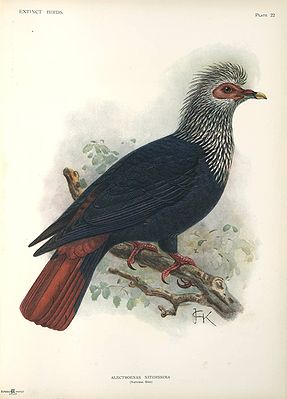Mauritius fruit pigeon
| Mauritius fruit pigeon | ||||||||||
|---|---|---|---|---|---|---|---|---|---|---|

Mauritius fruit pigeon |
||||||||||
| Systematics | ||||||||||
|
||||||||||
| Scientific name | ||||||||||
| Alectroenas nitidissima | ||||||||||
| ( Scopoli , 1786) |
The Mauritius fruit pigeon ( Alectroenas nitidissima ) is an extinct species of pigeon from the genus of the blue fruit pigeons ( Alectroenas ). It was endemic to Mauritius . When the French naturalist Pierre Sonnerat saw this pigeon for the first time in 1782, the plumage color reminded him of the Dutch flag and so he called it Pigeon Hollandais .
description
The Mauritius fruit pigeon reached a length of 30 cm. The wing length was 208 mm, the tail length 132 mm, the ridge length 25 mm and the barrel length 28 mm. The long white head, cloak and throat feathers were pointed. From the eyes to the cheeks to the lower jaw was a bare red facial skin. The body, wings, and thighs were indigo blue. The upper tail covers were dark red. The tail was dark red and marked black on the outside flags. The iris was red. The beak was gray with a yellowish tip. The feet were blue-gray.
Habitat and way of life
Little is known about the lifestyle of the Mauritius fruit pigeon, especially since only a few researchers have observed the species in the wild. Julien Desjardins wrote in his report Troisieme Rapp in 1832 that the Mauritius fruit pigeon could be found individually in forest remains near river banks and fed on fruits and freshwater mussels. Joseph François Charpentier de Cossigny (1690–1780) examined the stomach contents of a dead animal and wrote in 1755 that he had found four large seeds, which he first assigned to Calophyllum tacamahaca and later to Labourdonnaisia calophylloides . In 1790 a copy survived for a few months in the menagerie of Wilhelm V. Batavus Prince of Orange , where the voice was only described. During the day, cooing sounds could be heard and, during the night, a series of calls of ten to twelve "baf-baf-baf" sounds could be heard.
die out
The Mauritius fruit pigeon probably became extinct during the 1830s through overhunting, habitat destruction and nest looting by introduced long-tailed macaques . In an exchange of letters with René-Antoine Ferchault de Réaumur in 1755, Cossigny wrote that the pigeons had become rare as early as the 1730s as a result of the destruction of their habitat and the pursuit of refugee slaves. In 1782, Sonnerat reported rewards for killing harmful animals, including the Mauritius fruit pigeon. In 1801 Jacques Gérard Milbert was able to shoot several more specimens for food, but noted that the pigeons could only be found in the forests on the River Gorges. The last specimen was shot in 1826 by E. Geoffroy in a forest in the Savanne district, although Julien Desjardins remarked in 1832 that the pigeons could still be found in “the middle of those fine forests in the center of the island, which, because of their isolation, still existed did not fall victim to the ax ”.
There are three copies in the museum collections. The first from 1774 is in very poor condition and is in the Muséum national d'histoire naturelle in Paris. A second copy has been kept in the National Museum of Scotland in Edinburgh since 1819 . The third specimen shot by E. Geoffroy was initially acquired by Julien Desjardins and is now on display in the Mauritius Natural History Museum in Port Louis . In addition, there are two etchings in the Rijksarchief Den Haag , which were created between 1601 and 1603 and are considered the oldest representation of the species. In 2006 an expedition of the Mauritian-European Dodo Research Program found subfossil bones in the Mare-aux-Songes deposit , suggesting that the pigeons fell victim to a flash flood or a similar disaster.
Individual evidence
- ↑ a b Julien Desjardins: Troisieme Rapp. Ann. Trav. Soc. Hist. Nat. Maurice, 1832. ( Republished in 1972 by Madeleine Ly-Tio-Fane in Societé d'Histoire Naturelle de I'lle Maurice. Reports annuals I-IV, 1830-1834. Port Louis: Royal Society of Arts & Sciences of Mauritius)
- ↑ a b Charpentier de Cossigny: Treize lettres de Cossigny à Réaumur , ed. A. LaCroix, 1755. (Republished 1939–1940)
- ^ Pierre Sonnerat: Voyages aux Indes orientales et à la Chine. , Paris Froulé, 1782.
literature
- James C. Greenway: Extinct and Vanishing Birds of the World . Dover Publications Inc., New York 1967, ISBN 0-486-21869-4 .
- Errol Fuller: Extinct Birds . 2000, ISBN 0-8160-1833-2 .
- David Day: The Doomsday Book of Animals . Ebury Press, London 1981, ISBN 0-670-27987-0 .
- Dieter Luther: The extinct birds of the world . Westarp Sciences, 1986, ISBN 3-89432-213-6 .
- Walton Beacham: World Wildlife Fund Guide to Extinct Species of Modern Times . 1997, ISBN 0-933833-40-7 .
- Anthony Cheke & Julian Hume: Lost Land of the Dodo . T. & AD Poyser, 2008, ISBN 0-7136-6544-0 .
Web links
- Alectroenas nitidissimus in the endangered Red List species the IUCN 2008. Posted by: BirdLife International, 2004. Retrieved on 10 November, 2008.